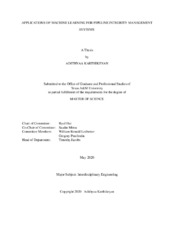| dc.contributor.advisor | Hur, Byul | |
| dc.contributor.advisor | Mirza, Saadat | |
| dc.creator | Karthikeyan, Adithyaa | |
| dc.date.accessioned | 2020-12-18T20:17:04Z | |
| dc.date.available | 2022-05-01T07:13:40Z | |
| dc.date.created | 2020-05 | |
| dc.date.issued | 2020-03-30 | |
| dc.date.submitted | May 2020 | |
| dc.identifier.uri | https://hdl.handle.net/1969.1/191704 | |
| dc.description.abstract | Oil and gas pipelines that traverse a river are often buried beneath the river bed and channel banks. One of the primary reasons for the exposure of buried pipelines is the scouring mechanism that occurs when the shear stress induced on riverbed by flowing water exceeds the resistance of channel bed material. Depending on the free spanning length and watercourse flow velocity, the vortex shedding phenomena may cause interactions resulting in a catastrophic pipeline failure and disrupting the integrity of the pipeline system. Hence it is essential to accurately predict Critical Span Length (CSL) and scour depth for river crossing pipelines.
Estimates of CSL and scour depth are found in literature subject to various governing factors. It is difficult to model the physics of the free span scenario considering all parameters associated with the pipeline. Advances in soft computing techniques has opened a whole new dimension to predict design parameters that are difficult to mathematically model, thus enabling protective preparations to maintain integrity and prevent failures.
In this study, we attempt to identify measurable factors to predict CSL and scour depth and understand the effect of these variables using Artificial Neural Networks. An Artificial Neural Network model is developed by collecting pipeline accident reports from Pipeline and Hazardous Materials Safety Administration (PHMSA) database for accidents that occurred due to Vortex Induced Vibration (VIV) loading during flooding in the last 35 years. This is done by identifying parameters that describe the pipeline including but not limited to pipe dimensions, pipe material properties, exposure flow rate, river velocity and dynamic lateral and vertical soil stiffness from real time data. The neural network model designed in MATLAB quickly and accurately predicts critical span length and scour depth for several river crossing pipelines and the results are compared to Finite Element Analysis and numerical simulations. This model can help us assess which flooding conditions would potentially cause a VIV failure in the pipe, once exposure flow rates and river velocities are estimated. | en |
| dc.format.mimetype | application/pdf | |
| dc.language.iso | en | |
| dc.subject | Artificial Neural Networks | en |
| dc.subject | Pipeline Integrity | en |
| dc.subject | River crossing pipelines | en |
| dc.subject | Scour depth | en |
| dc.subject | Critical Span Length | en |
| dc.subject | Vortex Induced Vibrations (VIV) | en |
| dc.subject | PHMSA | en |
| dc.subject | | en |
| dc.title | Applications of Machine Learning for Pipeline Integrity Management Systems | en |
| dc.type | Thesis | en |
| thesis.degree.department | College of Engineering | en |
| thesis.degree.discipline | Interdisciplinary Engineering | en |
| thesis.degree.grantor | Texas A&M University | en |
| thesis.degree.name | Master of Science | en |
| thesis.degree.level | Masters | en |
| dc.contributor.committeeMember | Ledbetter, William Ronald | |
| dc.contributor.committeeMember | Pearlstein, Gregory | |
| dc.type.material | text | en |
| dc.date.updated | 2020-12-18T20:17:04Z | |
| local.embargo.terms | 2022-05-01 | |
| local.etdauthor.orcid | 0000-0002-5886-7251 | |


